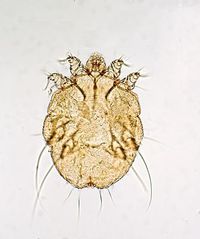Sarcoptes scabiei


Etiology/Bacteriology
Taxonomy
| Domain = Animalia | Phylum = Eumetazoa | Class = Arachnida | Order = Astigmata | Family = Sarcoptidae | Genus = [[Sarcoptes]] | species = [[Sarcoptes scabies]]
|
NCBI: Taxonomy Genome: [] |
Description
Pathogenesis
Transmission
Sarcoptes scabiei is transmitted via person to person contact. Usually prolonged contact is required for scabies to spread [1]. Consequently, household members and significant others are the significant mode of transmission. The most common source of infection in adults is from sexual partners. Scabies may be spread via inanimate objects such as clothing and bedding but the chances are significantly low because scabies do not survive for more than two-three days without human contact [1]. If the symptoms of scabies have become severe enough to cause crusted scabies, transmission via clothing and other articles increases significantly.
Infectious dose, incubation, and colonization
Sarcoptes scabiei is a parasite of the skin which lends to a low infectious dose because many times colonization only requires the transfer of one parasite. If the parasite transmitted is an adult female carrying fertilized eggs, colonization is almost always assured unless the parasite is washed off within a 30 minutes of the transfer period. Adult males hardly ever burrow accept to follow a female burrow path for mating purposes [2]. Before burrowing, <Sarcoptes scabiei will crawl to bodily crevices such as the elbows, feet, ankles, hands, and genital area. The parasite will then burrow into host skin using its front legs and mouth to cut away the skin in a typical zig-zag pattern. As the female parasite burrows it will lay eggs along the way. An adult female will continue to lay 2-3 eggs a day for two months until it dies. The life cycle of Sarcoptes scabiei is separated into four stages. Initially, the eggs will hatch into larvae within three days of being laid. The larvae will feed off of host hair follicles until it molts into an eight-legged nymph [2] At this point, all nymphs are destined to be males. If nymph molts another time, it will become a female. The first round of molting takes lasts for 10 days. If a second molting event occurs, then another 7 days is required to complete the female formation. Consequently, the females will be much larger than their male counterparts because they have nearly double the time to scavenge nutrients before complete development. Mating only occurs once in the lifetime of each parasite because the females can carry the sperm for two months while continually fertilizing new eggs. Soon after the two month fertile period the female will die.
